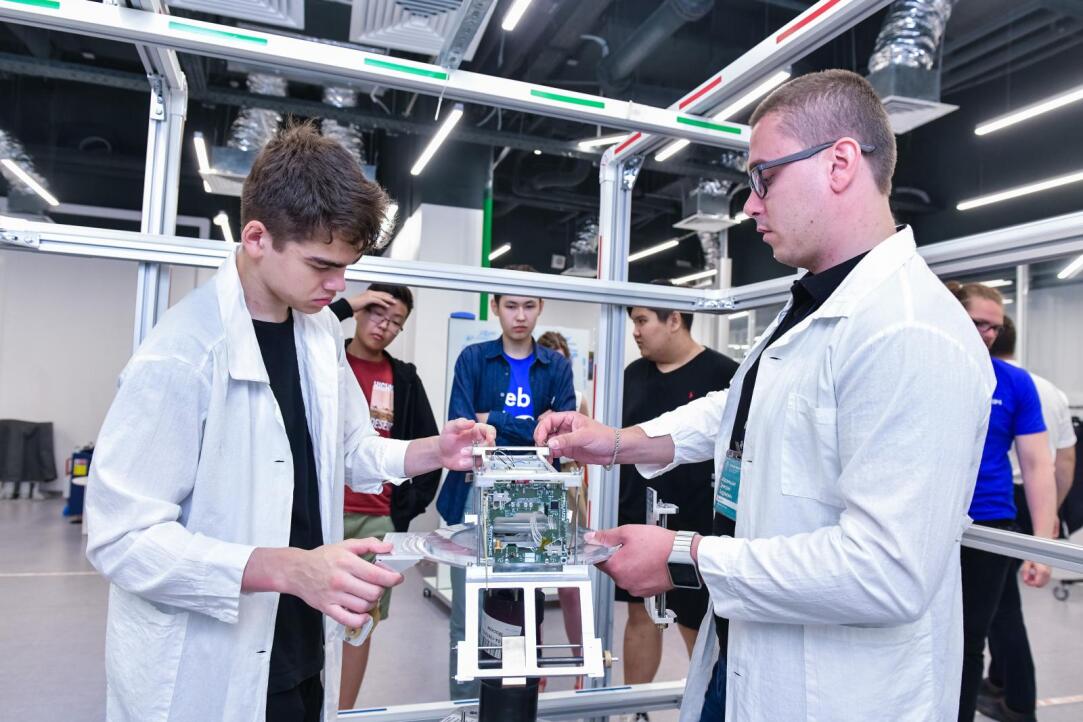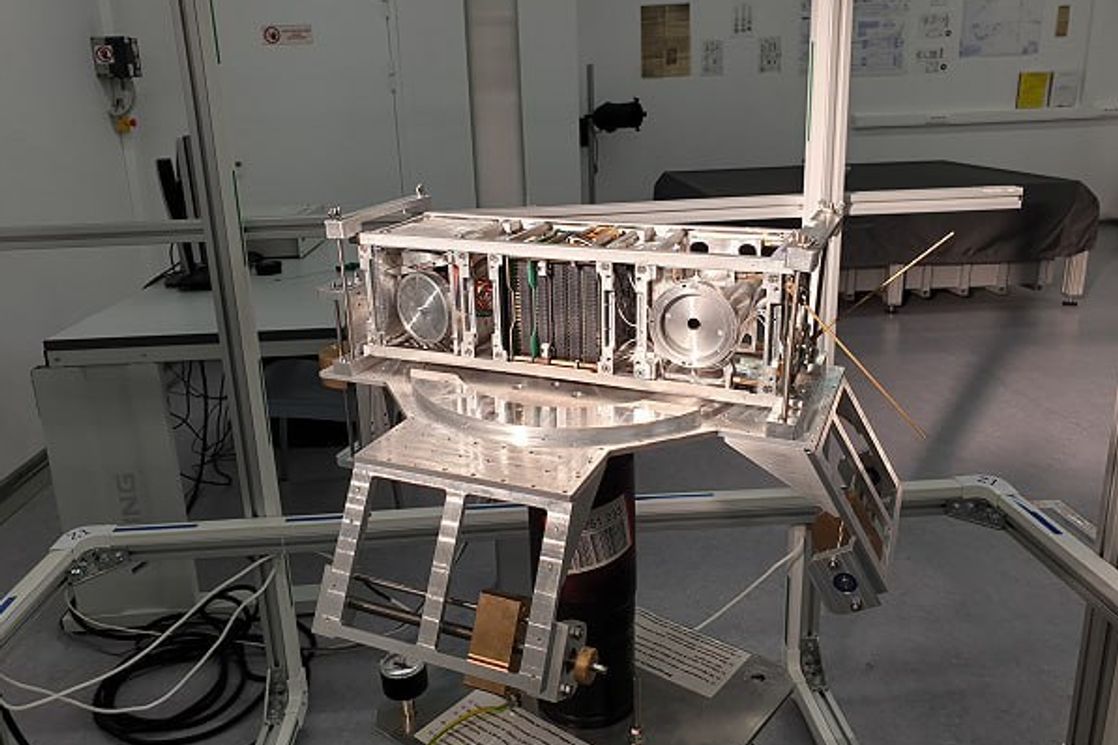‘We Demonstrated That HSE University Can Not Only Build a Satellite, but Maintain Its Operation’

The first HSE University satellite has completed its work in orbit after more than 35,000 hours of trouble-free operation, one billion kilometres travelled (24,600 orbits around the Earth), and hundreds of full-frame shots taken of the Earth's surface across an area of 320,000 km2. The HSE News Service shares the results of the satellite’s mission and the team’s plans for the near future.
The CubeSX-HSE and CubeSX-Sirius-HSE satellites were the first CubeSats launched by HSE University and the Sirius Educational Centre. The global SatNOGS catalogue now lists both devices as ‘Decayed,’ officially signalling the completion of a four-year orbital mission—three times longer than their formal one-year warranty and almost double the statistically reliable limit for standard CubeSat platforms.
Launched on March 22, 2021, on a Soyuz-2.1 commercial flight with a Fregat unit, the pair of three-unit satellites entered a Sun-synchronous orbit about 550 km high alongside three dozen more satellites. The initial estimated life of the OrbiCraft-Pro platform—12 months of active operation—was chosen as a compromise between expense and statistics; according to industry estimates, the probability of maintaining the functionality of a classic CubeSat a year after launch does not exceed 60%. This makes the final outcome all the more impressive: a four-year, trouble-free marathon spanning about one billion km (24,600 orbits), the equivalent of several dozen round trips from Earth to Mars. The final descent began in April–May 2025, when the perigee of both vehicles dropped below 200 km; the calculated models showed a linear increase in aerodynamic drag.
The main scientific programme was carried out by the world's first flat harmonic diffractive lens, with a diameter of 10 mm and embedded in a 3D-printed metal camera box. A series of calibration surveys proved that ultrathin optics produce an image comparable to classical refractive optics; the results are described in an article in Remote Sensing 14 (9): 2230 (2022). In total, the pair of satellites collected more than 320 full-frame shots of the Earth's surface, from the cellular clouds of the Barents Sea to the spring flood on the Volga, with a total area of over 300,000 km2, a milestone recorded by the HSE team at the three-year mark of the mission.

The reliability of the on-board electronics surpassed even optimistic forecasts: the total operating time of critical modules exceeded 35,000 hours without a single emergency restart. The chosen form of open channel, an AX.25 amateur radio format in the UHF range, played an important role. This meant that only the SatNOGS network of ground stations was able to receive and decrypt over 4,000 sessions (three leading observers monitored the broadcasts almost daily until the satellites’ orbits decayed), and each successfully decoded transmission appeared in real time in the open SatNOGS API.
The mission also served as a vibrant educational platform. Over the past four years, more than 15 students have taken part in the work of the MIEM Mission Control Centre, and Sirius students have had an opportunity to plan real orbital experiments for the first time, from drawing up daily transmission schedules to processing received telemetry. This experience gave rise to the idea of annual launches: in 2022 and 2023, CubeSX-HSE-2 and CubeSX-HSE-3 went into orbit with new payloads and improved modules.
The CubeSX-HSE and CubeSX-Sirius-HSE have achieved all their stated goals: demonstrating the performance of ultralight diffraction optics, collecting hundreds of valuable images, serving as an open data showcase for amateurs and professionals, and most importantly, training a new generation of small-spacecraft engineers. The CubeSats burned up at an altitude of about 80 km, but the code, data, and accumulated experience have already been passed on to the next participants of the Space-π programme. For them, the four-year record of the first university satellites is no longer an unattainable dream, but a new bar to pass.
Meanwhile, CubeSX-HSE-3, launched in June 2023, continues to operate in orbit. It transmits thousands of messages daily, and its telemetry confirms that the on-board electronics are operating normally and the solar panels are charging the batteries stably.
A new satellite will be sent into a Sun-synchronous orbit in the fourth quarter of 2025, while a sixth satellite focused on experiments with new materials is expected to be launched in 2026—thus tripling the amount of scientific data produced.

Dmitrii Abrameshin
Dmitrii Abrameshin, Head of the Mission Control Centre, Leading Engineer at the HSE Laboratory of Space Vehicles and Systems' Functional Safety, noted: ‘We demonstrated that HSE University can not only build a satellite, but also maintain its operation for a long time. CubeSX-HSE-3 has started providing fresh data for our archive, and the devices that we plan to launch in 2025 and 2026 will be capable of onboard data processing and prove that even a CubeSat can become a full-fledged orbital laboratory.’
See also:
HSE Scientists Optimise Training of Generative Flow Networks
Researchers at the HSE Faculty of Computer Science have optimised the training method for generative flow neural networks to handle unstructured tasks, which could make the search for new drugs more efficient. The results of their work were presented at ICLR 2025, one of the world’s leading conferences on machine learning. The paper is available at Arxiv.org.
Physicists Propose New Mechanism to Enhance Superconductivity with 'Quantum Glue'
A team of researchers, including scientists from HSE MIEM, has demonstrated that defects in a material can enhance, rather than hinder, superconductivity. This occurs through interaction between defective and cleaner regions, which creates a 'quantum glue'—a uniform component that binds distinct superconducting regions into a single network. Calculations confirm that this mechanism could aid in developing superconductors that operate at higher temperatures. The study has been published in Communications Physics.
Neural Network Trained to Predict Crises in Russian Stock Market
Economists from HSE University have developed a neural network model that can predict the onset of a short-term stock market crisis with over 83% accuracy, one day in advance. The model performs well even on complex, imbalanced data and incorporates not only economic indicators but also investor sentiment. The paper by Tamara Teplova, Maksim Fayzulin, and Aleksei Kurkin from the Centre for Financial Research and Data Analytics at the HSE Faculty of Economic Sciences has been published in Socio-Economic Planning Sciences.
Larger Groups of Students Use AI More Effectively in Learning
Researchers at the Institute of Education and the Faculty of Economic Sciences at HSE University have studied what factors determine the success of student group projects when they are completed with the help of artificial intelligence (AI). Their findings suggest that, in addition to the knowledge level of the team members, the size of the group also plays a significant role—the larger it is, the more efficient the process becomes. The study was published in Innovations in Education and Teaching International.
New Models for Studying Diseases: From Petri Dishes to Organs-on-a-Chip
Biologists from HSE University, in collaboration with researchers from the Kulakov National Medical Research Centre for Obstetrics, Gynecology, and Perinatology, have used advanced microfluidic technologies to study preeclampsia—one of the most dangerous pregnancy complications, posing serious risks to the life and health of both mother and child. In a paper published in BioChip Journal, the researchers review modern cellular models—including advanced placenta-on-a-chip technologies—that offer deeper insights into the mechanisms of the disorder and support the development of effective treatments.
Advancing Personalised Therapy for More Effective Cancer Treatment
Researchers from the International Laboratory of Microphysiological Systems at HSE University's Faculty of Biology and Biotechnology are developing methods to reduce tumour cell resistance to drugs and to create more effective, personalised cancer treatments. In this interview with the HSE News Service, Diana Maltseva, Head of the Laboratory, talks about their work.
Solvent Instead of Toxic Reagents: Chemists Develop Environmentally Friendly Method for Synthesising Aniline Derivatives
An international team of researchers, including chemists from HSE University and the A.N. Nesmeyanov Institute of Organoelement Compounds of the Russian Academy of Sciences (INEOS RAS), has developed a new method for synthesising aniline derivatives—compounds widely used in the production of medicines, dyes, and electronic materials. Instead of relying on toxic and expensive reagents, they proposed using tetrahydrofuran, which can be derived from renewable raw materials. The reaction was carried out in the presence of readily available cobalt salts and syngas. This approach reduces hazardous waste and simplifies the production process, making it more environmentally friendly. The study has been published in ChemSusChem.
‘The Goal Is to Create Something New for My Country’
Maria Andreeva became interested in satellite engineering in Year 6. Then, she was a prize-winner of the Top Class (Vysshiy Pilotazh) competition, gave lectures for school students, and took part in meetings with the President of Russia, Vladimir Putin. Two years ago, a satellite she helped develop was launched into space. This year, Maria entered HSE University to study on the Information Science and Computation Technology programme delivered by the HSE Tikhonov Moscow Institute of Electronics and Mathematics (MIEM). In an interview with the HSE News Service, the first-year student spoke about her passion for space and the opportunities she has found at the university.
Master’s Students of HSE, University of Campinas, and Tsinghua University Publish Joint Student Research Collection
Master’s students of the HSE ISSEK programme ‘Science, Technology and Innovation Management and Policy’ have released a joint research collection with the University of Campinas (Brazil) and Tsinghua University (China) titled ‘Being Innovative or Being on the Safe Side—Managing the Risk of Failure.’ The authors explore how organisations perceive risks and embrace innovation within different cultural contexts.
‘A Turn Away from Stereotypes’: Moscow Hosts ‘Researching the Deaf Community’ Conference
On October 17–19, 2025, the third annual interdisciplinary conference ‘Researching the Deaf Community 2025: on the Periphery of Attention’ took place at GES-2 House of Culture in Moscow. The event was organised with the participation of the HSE International Laboratory for Social Integration Research. HSE University Vice Rector Irina Martusevich addressed attendees at the opening ceremony.


